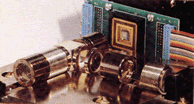| enginuity |
|
Switched on
A free-space optical switch has been pioneered by the Cambridge photonics group, headed by Prof Bill Crossland and Dr Robert Mears. The switch consists of 30,000 mirrors set into a silicon chip integrated circuit. Each mirror is 15µm square and can be electrically switched on and off. A layer of ferroelectric liquid crystal covered by glass gives the potential of optically signalling information out of the Si chip, which can be received by a similar component set up as a receiver. This type of device can be used in optical systems to connect two bundles of fibre optic cables and the free-space optical switch allows any one fibre coming in to be connected to any of the outgoing fibres.
'One way of visualising free-space optical interconnections,' explains Prof Crossland, 'is to think of a 35mm slide projected on to a screen. There are millions of optical links between each point on the slide and their corresponding images on the screen. In a similar way, free-space optics can be used to produce millions of connections within a circuit. We are using the 3D properties of light to convey information.'

Prototype free-space photonic switch developed as part of a LINK project on optically connected parallel machines, sponsored by British Aerospace, Bell Northern Research Europe, the University of Bath and Heriot-Watt University.
The switches themselves can be operated either by turning individual mirrors 'on' and 'off', in which case some light is lost, or by writing holograms on arrays of mirrors and programming them to deflect the light to the position required. Using this method, all the light is transferred from input to output.
The switching speeds of individual mirrors do not compete with the switching speeds of fast electronic gates. However, light beams carrying very large amounts of information can be switched by one mirror in fibre optic switches. In chip-to-chip interconnects, the vast number of connections that can be made using optics rather than wires means that higher data rates may be obtained.
The Cambridge group already make these devices which are also manufactured commercially by Thorn EMI. Three main application areas have been selected for study. One is optical switching as described above, the second is neural networks for computational work and the third is an image-processing application which is used in the production of optical correlators. The idea of producing optical correlators, which will match an image to a visual input, as a form of recognition, has been around for a long time, but the technology of optical rather than electronic devices has enabled systems sufficiently compact for 'on-board' use, to be produced.
A current application, studied in a joint ESPRIT program, will form part of a driver advice system, which is mounted on a car and asked to recognise various road signs, by correlating the perceived image with a stored image. Other uses include finger-print matching, security systems, defence applications and number plate recognition.
Further information from Prof Bill Crossland on: (01223) 330264.
| number 3, summer '94 |